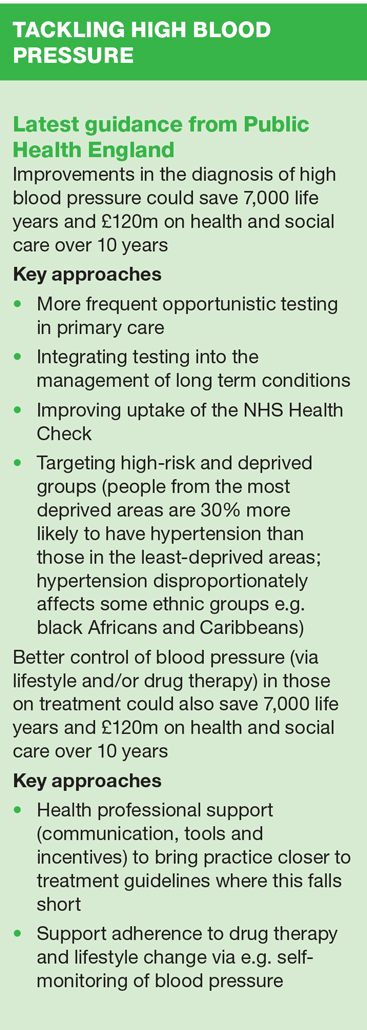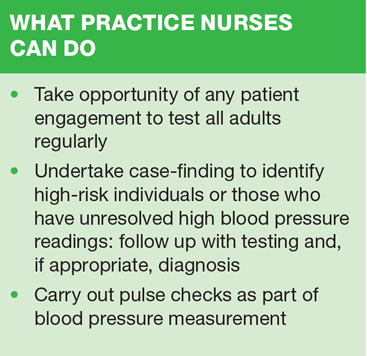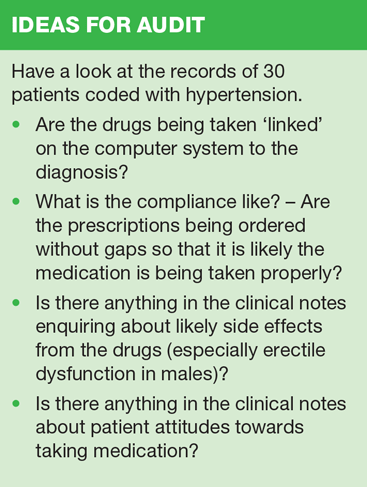Hypertension:why we measure it, why we treat it
Dr Ed Warren
Dr Ed Warren
FRCGP
GP, Sheffield, GP trainer Barnsley VTS
As Public Health England launches an initiative to increase blood pressure testing to improve the diagnosis – and treatment – of hypertension, Practice Nurse examines why we measure blood pressure, what blood pressure is, and what a diagnosis of hypertension really means
Blood pressure measurement is probably the most performed screening test in modern medicine. It has been phenomenally successful: an estimated 40% of the world’s population has hypertension, and the ever dropping threshold for diagnosing the condition keeps the numbers rising. Yet great uncertainty surrounds the value of making the diagnosis of mild hypertension, which affects a fifth of the world’s population. Most people with mild hypertension are treated with drugs, say Stephen Martin and colleagues,1 yet the evidence indicates ‘no net benefit from drug treatment of mild hypertension in people without the higher risks of diabetes or chronic heart disease.’ What is going on?
However, the proportion of English adults aware of their high blood pressure is at least 10% behind detection levels in the US, and 15% behind those in Canada, and GP practices have, on average, no blood pressure reading in the last five years for 10% of adults aged 40 and over.2 It is estimated that there are likely to be over 5 million people in England alone with undiagnosed high blood pressure.2
SCENARIO
George is 61 and an infrequent surgery attender. He has come for the Health Check to which you have invited him. You measure his blood pressure and it is 160/92 mmHg (you have no previous readings for comparison). You tell him the result and he asks: ‘What should my blood pressure be?’
WHAT IS HYPERTENSION?
In 1896 the Italian physician Scipione Riva-Rocci described a method of measuring blood pressure (BP) using a cuff and a pressure-measuring device employing a column of mercury in a glass tube (do you remember when it was thought alright to have toxic heavy metals available to spill all over the floor in a doctors’ surgery?). Later, in 1905, the Russian vascular surgeon Nikolai Segeivich Korotkov described the method of using a stethoscope to listen for the pulse (Riva-Rocci used to feel the pulse), which has pretty much been the normal way of measuring blood pressure ever since.
However, it was only towards the end of the last century that the health impact of raised blood pressure came to be appreciated and a serious attempt was made to treat it. This caused consternation, not least among our patients, who had previously associated the need for medical treatment with the experience of undesirable symptoms. So in a sense, doctors ‘invented’ hypertension, an illness with (except in severe cases) no symptoms, and only important because of what it might lead to.
George’s question is perfectly valid, and yet does not have an easy answer. The first question is: ‘what is George’s real blood pressure?’ Taking blood pressure in a clinic session can be misleading. Correct technique is important: for example if the arm is not supported at the level of the heart this can alter readings significantly, to the extent that treatment may be influenced.3 Nurses obtain lower readings than doctors.4 Using an ordinary sphygmomanometer, blood pressure should be measured between 10 and 13 times before an accurate assessment can be made.5 It appears that self-monitoring at home is the best way of measuring blood pressure,5 (validated machines can be bought – but not prescribed – for as little as £10,6) but people with hypertension are reluctant to use home readings long term or as a means of altering treatment.7 Unless it is very high, all people who present for the first time with raised blood pressure should be offered 24 hour ambulatory BP monitoring (ABPM) , and this should also be used for monitoring in any hypertensive for whom there may be a ‘white coat’ effect (blood pressure which rises when someone tries to measure it).8
Both NICE CKS8 and SIGN9 agree that ‘normal’ blood pressure is a systolic BP below 140mmHg and a diastolic BP below 90mmHg. Keep in mind that these are sustained readings, and not just one-off. Further, four types of hypertension are described:
Stage 1: BP ≥ 140/90 mmHg (either or both systolic and diastolic), equates to ambulatory/home readings ≥ 135/85mmHg
Stage 2: BP ≥ 160/100mmHg, ambulatory/home readings ≥150/95mmHg
Stage 3: BP ≥ 180/110mmHg
Isolated systolic hypertension: Systolic BP > 160mmHg
In addition, if you come across a reading of >220/120mmHg then let a doctor know as your patient may need hospital admission.
About 30% of people aged 45-54 have Stage 1 hypertension, as do 70% of those aged more than 75.8
Stage 1 hypertension only benefits from treatment if the overall cardiovascular disease (CVD) risk (using a risk tool such as QRISK2) exceeds 20% over 10 years.8 Stage 2 hypertension benefits from treatment whatever the underlying CVD risk measurement. Stage 3 hypertension benefits from treatment as soon as it is detected, without waiting for the 24-hour BP monitor.8
In summary, someone has hypertension if they would benefit from their blood pressure being lower.9
SCENARIO 2
Eric is 70 and has been to see you several times in your Hypertension Clinic. He is confirmed with Stage 2 Hypertension, and has been coded accordingly. Eric is not overweight, he stopped smoking in 1974, only has a glass of beer on Sunday lunchtime, and goes ballroom dancing three times a week. But Eric does not like taking tablets. On closer questioning you find out that a friend of his suffered erectile problems when he started on pills for his blood pressure, but aside from this Eric wants to determine his health for himself.
TREATING HYPERTENSION
People with hypertension do get some benefit if their blood pressure is lowered. Hypertension increases the risks of stroke, heart attack and peripheral vascular disease between 2- and 3-fold.8 Lowering diastolic blood pressure by 5 mmHg for 5 years reduces the risk of stroke by 38% and the risk of heart attack by 16%, with an overall reduction in vascular mortality of 21%.11 These are relative risks, so that people with the greatest underlying risk have more to gain from treatment. Hypertension is only one of a number of known risk factors for cardiovascular disease. Tools for assessing risk are getting better, but none is 100% accurate – much variability in the incidence and prevalence of CVD is not explained using the current risk tools.
Some patients will want treatment whatever the side effects. Others like Eric will be more circumspect. So what is the best method of presenting the risks of high blood pressure in an understandable way to inform management choices? The NHS has produced a computerised Decision Aid for people with hypertension.12 Out of 100 people treated for their hypertension for 10 years, 80 will not have a heart attack or stroke whether or not their BP is controlled; 15 will have a heart attack or stroke even though their BP is controlled; only five will be saved from having a heart attack or stroke because their BP is under control.
All medicines are ‘poisons’, in so far as they are doing things to your body that would not have occurred without them. Side effects are inevitable. Levels of side effects are unfortunately high when treating hypertension, especially for older hypertension drugs. Treatment is usually for life, so that the presence of drug side effects can become very wearing. For instance up to 53% of men on drug treatment for hypertension have some degree of sexual dysfunction, compared with 7% of controls and 20% of untreated hypertensives.13 The drop-out rates in clinical trials have been as high as 40%, and this is in populations who are having a lot of medical support. In the ‘real world’ drop-out rates of up to 50% can be expected, and this does not depend on the type of medication used.14 Four fifths of patients who stop drug treatment do so because of side effects, and a quarter do not tell their GP.15 When the benefits and drawbacks of drug treatment have been explained to them, it is not unusual for patients to decline medication.
There are other costs. For those who pay, a prescription cost for a month is now ironically about the same as a pack of 20 cigarettes: it is not uncommon to require two or three drugs to get good blood pressure control. Clinics have to be attended and blood tests endured, even if all is going well. But more important to people like Eric, the person with a diagnosis of hypertension is now a ‘patient’ – some autonomy has been taken away and he has to obey the rules of being ill. Some people delight in this role, but many more feel diminished by their fate.
The guidelines suggest that as well as medication, patients with hypertension should be given lifestyle advice.8,9 People with hypertension who achieve lifestyle changes also have better outcomes – it is estimated that improved lifestyle is about the equivalent of one antihypertensive drug.16 Luckily the lifestyle advice appropriate in hypertension (more exercise, more vegetables, less smoking, less alcohol, less calories, less fat) is identical to the lifestyle advice appropriate for other long term conditions such as diabetes or heart disease. The downside is that in most cases a person’s lifestyle is influenced by many factors outside medical control: cigarette, alcohol and food marketing, the availability of recreational activities. ‘Brief advice’ (advising patients what to change and why) is the only intervention even remotely practicable considering the many other demands on primary care time, but unfortunately there is little evidence that on its own it makes any worthwhile difference to patient behaviour.17
THE PRACTICE HYPERTENSION CLINIC
The Quality and Outcomes Framework (QOF) is making all practices do what many were doing before. Having recognised that the treatment of hypertension requires a call and recall system, and that best care is only secured when regular monitoring is achieved, the next step is to set up systematic hypertension care in the practice. Running such clinics is usually delegated to the only practice clinicians who can be relied upon to run them properly – practice nurses.
For 2014-15, the QOF requirements for hypertension are a slimmed-down version of previous years. Only 2 indicators remain: HYP001 and HYP006. One requires the maintenance of a register of people being treated for hypertension. The other suggests a treatment target of 150/90mmHg (which we will come back to later). In addition to these requirements, many practice templates will include some annual blood tests. In my own practice an annual HbA1c is done: diabetes is another risk factor for CVD and incidence tends (like blood pressure) to rise with time. Cholesterol is measured: another risk factor, which also rises with age. Urea and electrolyte measurement assesses kidney function: hypertension and its medication can damage kidneys, and damaged kidneys raise blood pressure. Treating hypertension is all about preventing CVD: it is not the blood pressure that kills; it is what it sometimes leads to.
The clinical protocol developed for your clinic will usually contain guidance about how to deal with unexpected BP readings. The idea of targets is grist to the performance manager’s mill as targets can be set and monitored with the minimum of imagination. Unfortunately the research on hypertension suggests that risk is linearly related to BP level, so there is no obvious cut-off below which there is no risk. The present QOF target BP is 150/90mmHg: last year there was an additional target of 140/90mmHg, achieving more ‘points’ and consistent with the NICE treatment target.
NICE recommends a target on treatment of 140/90mmHg for patients under 80 and 150/90mmHg for those over 80. For the younger patients, there is no evidence that lowering BP further is associated with a reduction in morbidity or mortality.18 Older patients also benefit from having their BP normalised, and indeed are more prone anyway to the illnesses that lowering BP protects against. However they are also more likely to be taking other medicines which interact with the blood pressure drugs and to be less tolerant of side effects – a prime example would be episodes of hypotension which in a younger person might lead to a temporary unsteadiness, but in an older person could lead to a fall and a fractured hip. SIGN still recommends a target of 140/90mmHg across the board.8
Some groups require a different treatment target, invariably because they have something else wrong with them other than their hypertension. For example, in those with diabetes: NICE CKS recommends 130/80mmHg in those with eye, kidney or cerebrovascular problems, and 140/80mmHg in the rest;19 SIGN also suggests 130/80mmHg if complications are present;9 and the QOF suggests 140/80mmHg but there is an additional ‘audit standard’ of 150/90mmHg, with the lower target getting more points, and there is no mention of a different target for diabetes with complications.
CONCLUSION
It is now many years since Julian Tudor Hart coined the phrase ‘Rule of Halves’.20 This is applicable to all chronic diseases, but he did his own work on blood pressure in his general practice population in South Wales. Half of hypertension is diagnosed, half of this is treated, and half of patients on treatment are treated adequately. In recent years it is to be hoped that the situation has improved, but the guidance from Public Health England suggests that the Rule of Halves is still largely true.
Yet hypertension is only one piece of the cardiovascular disease jigsaw. It has no symptoms but is a latent killer and disabler; and it generates numbers which can be used and abused. As evidence-based professionals we should be aware of the limitations as well as the benefits of diagnosing and treating hypertension. Once the need for treatment is agreed with your patient (with the emphasis on ‘agreement’) then the task should be pursued with efficiency and enthusiasm.
REFERENCES
1. Martin SA, Boucher M, Wright JM, et al. Mild hypertension in people at low risk. BMJ 2014;349:g5432
2. Public Health England. Tackling high blood pressure: From evidence into action, 2014 https://www.gov.uk/government/uploads/system/uploads/attachment_data/file/375985/20141018_Tackling_high_blood_pressure_-_FINAL_INCL_LINK_CHANGES.pdf
3. O’Brien E T, Petrie J C, Littler W A et al. Blood Pressure Measurement: Recommendations of the British Hypertension Society, Third Edition. London:Br Med J,1997
4. A’Court C, McManus RJ. Why are doctors still measuring blood pressure? Br J Gen Pract 2014;64:168-9.
5. Warren RE et al. Variability of office, 24-hour ambulatory, and self-monitored blood pressure measurements. Br J Gen Pract 2010;60:675-80
6. British Hypertension Society. Blood pressure monitors validated for home use. http://www.bhsoc.org//index.php?cID=246
7. Jones MI et al. Patients’ experiences of self-monitoring blood pressure and self-titration of medication: the TASMINH2 Trial. Br J Gen Pract 2012;62:90-91.
8. NICE Clinical Knowledge Summaries. Hypertension – not diabetic. http://cks.nice.org.uk/hypertension-not-diabetic
9. Scottish Intercollegiate Guidelines Network (SIGN). Heart Disease. December 2012.
10. Hampton J. Managing hypertension in primary care. Update 2001;53:86-90.
11. Lowering blood pressure in particular patient groups. Drug and Therapeutics Bulletin 2001;39(5):37-40.
12. NHS Shared Decision Making. Deciding what to do about high blood pressure. www.patient.co.uk
13. Riley A and Riley E. Antihypertensive drugs and sex. Journal of Sexual Health 1992;19:31-2.
14. Jones J K, Gorkin L, Lian J F et al. Discontinuation of and changes in treatment after start of new courses of antihypertensive drugs: a study of a United Kingdom population. Br Med J 1995;311:293-5.
15. Preventing strokes and saving lives. London:The Stroke Association,1995.
16. Nicoll R, Henein MY. Hypertension and lifestyle modification: how useful are the guidelines? Br J Gen Pract 2010;60:879-80.
17. Butler CC et al. Training practitioners to deliver opportunistic multiple behaviour change counselling in primary care: a cluster randomised trial. BMJ 2013;346:10.
18. Arguedas JA, Perez MI, Wright JM. Treatment blood pressure targets for hypertension. Cochrane Database of Systematic Reviews 2009, Issue 3.
19. NICE CKS. Diabetes – type 2. cks.nice.org.uk/ [Accessed 31.7.14]
20. Hart JT. Rule of halves: implications of increasing diagnosis and reducing dropout for future workload and prescribing costs in primary care. Br J Gen Pract. Mar 1992; 42(356): 116–119.
Related articles
View all Articles


